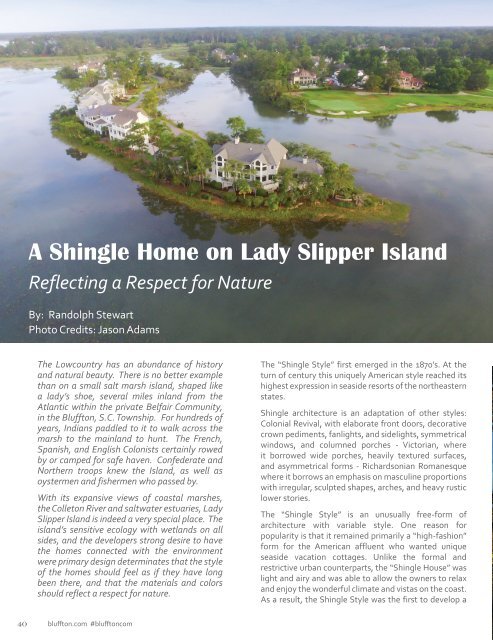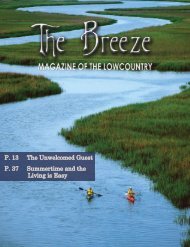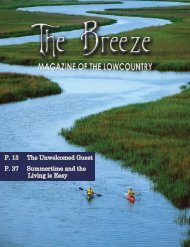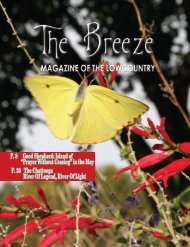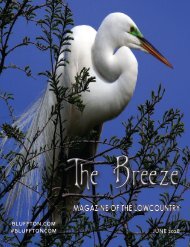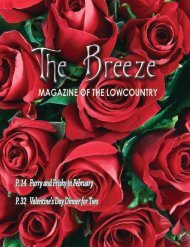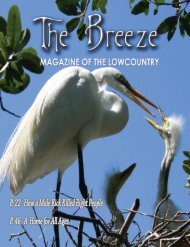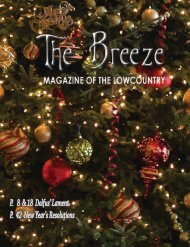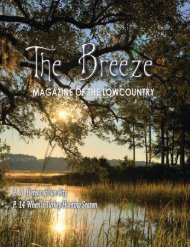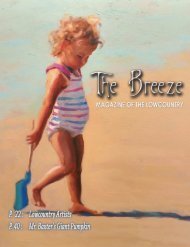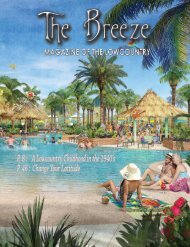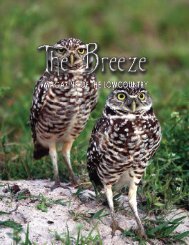Create successful ePaper yourself
Turn your PDF publications into a flip-book with our unique Google optimized e-Paper software.
A Shingle Home on Lady Slipper Island<br />
Reflecting a Respect for Nature<br />
By: Randolph Stewart<br />
Photo Credits: Jason Adams<br />
<strong>The</strong> <strong>Lowcountry</strong> has an abundance <strong>of</strong> history<br />
and natural beauty. <strong>The</strong>re is no better example<br />
than on a small salt marsh island, shaped like<br />
a lady’s shoe, several miles inland from <strong>the</strong><br />
Atlantic within <strong>the</strong> private Belfair Community,<br />
in <strong>the</strong> Bluffton, S.C. Township. For hundreds <strong>of</strong><br />
years, Indians paddled to it to walk across <strong>the</strong><br />
marsh to <strong>the</strong> mainland to hunt. <strong>The</strong> French,<br />
Spanish, and English Colonists certainly rowed<br />
by or camped for safe haven. Confederate and<br />
Nor<strong>the</strong>rn troops knew <strong>the</strong> Island, as well as<br />
oystermen and fishermen who passed by.<br />
With its expansive views <strong>of</strong> coastal marshes,<br />
<strong>the</strong> Colleton River and saltwater estuaries, Lady<br />
Slipper Island is indeed a very special place. <strong>The</strong><br />
island’s sensitive ecology with wetlands on all<br />
sides, and <strong>the</strong> developers strong desire to have<br />
<strong>the</strong> homes connected with <strong>the</strong> environment<br />
were primary design determinates that <strong>the</strong> style<br />
<strong>of</strong> <strong>the</strong> homes should feel as if <strong>the</strong>y have long<br />
been <strong>the</strong>re, and that <strong>the</strong> materials and colors<br />
should reflect a respect for nature.<br />
<strong>The</strong> “Shingle Style” first emerged in <strong>the</strong> 1870’s. At <strong>the</strong><br />
turn <strong>of</strong> century this uniquely American style reached its<br />
highest expression in seaside resorts <strong>of</strong> <strong>the</strong> nor<strong>the</strong>astern<br />
states.<br />
Shingle architecture is an adaptation <strong>of</strong> o<strong>the</strong>r styles:<br />
Colonial Revival, with elaborate front doors, decorative<br />
crown pediments, fanlights, and sidelights, symmetrical<br />
windows, and columned porches - Victorian, where<br />
it borrowed wide porches, heavily textured surfaces,<br />
and asymmetrical forms - Richardsonian Romanesque<br />
where it borrows an emphasis on masculine proportions<br />
with irregular, sculpted shapes, arches, and heavy rustic<br />
lower stories.<br />
<strong>The</strong> “Shingle Style” is an unusually free-form <strong>of</strong><br />
architecture with variable style. One reason for<br />
popularity is that it remained primarily a “high-fashion”<br />
form for <strong>the</strong> American affluent who wanted unique<br />
seaside vacation cottages. Unlike <strong>the</strong> formal and<br />
restrictive urban counterparts, <strong>the</strong> “Shingle House” was<br />
light and airy and was able to allow <strong>the</strong> owners to relax<br />
and enjoy <strong>the</strong> wonderful climate and vistas on <strong>the</strong> coast.<br />
As a result, <strong>the</strong> Shingle Style was <strong>the</strong> first to develop a<br />
40<br />
bluffton.com #blufftoncom


